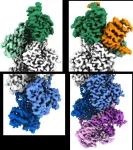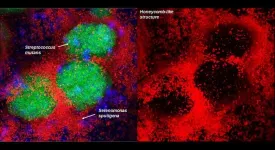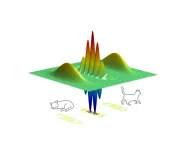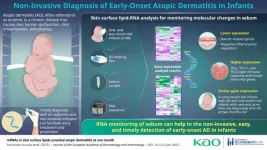(Press-News.org) Actin filaments — protein structures critical to living movement from single cells to animals — have long been known to have polarity associated with their physical characteristics, with growing “barbed” and shrinking “pointed” ends. The ends of the filament are also different in the way they interact with other proteins in cells. However, the mechanism that determines these differences has never been entirely clear to scientists. Now, researchers from the Perelman School of Medicine at the University of Pennsylvania have revealed key atomic structures of the ends of the actin filament through the use of a technique called cryo-electron microscopy (cryo-EM). The study, published in Science, provides fundamental insights that may help fill in details behind disorders affecting some muscle, bone, heart, neurological, and immune disorders that are the result of actin defects or deficiencies.
Actin is the most abundant protein inside the cells of higher organisms, such as animals. It serves as the building-block for long, thin structures called filaments, which provide key structural support as part of the cell “cytoskeleton,” the system that gives cells their shape and polarity. Rapid changes in actin filaments underlie key cellular events such as movement along surfaces, cell-to-cell contact, and cell division. Actin filaments also are major elements in muscle fibers.
“The results of our study provide a mechanistic understanding of a process we have known about for more than 40 years, referred to as filament treadmilling, and impacts how we view the cellular roles of actin in health and disease,” said the study senior author Roberto Dominguez, PhD, the William Maul Measey Presidential Professor of Physiology at Penn.
The dynamics of actin filaments are governed largely by the “treadmilling” process, through which individual actin proteins are shed from one filament end, known as the pointed end, and added at the other, barbed end. Actin filaments can be stabilized by distinct so-called “capping” proteins that bind to the filament ends to stop further addition or loss of individual actin proteins. Many other proteins also bind to the barbed and pointed ends of the actin filament. But the structural details determining the specificity of these interactions — the details that explain why these two ends function so differently — have been murky.
In their study, the researchers, including two Penn students — Peter Carman, PhD, a recent graduate student in Dominguez’s lab, and Kyle Barrie, PhD, a graduate student currently in the lab, who served as co-first authors — analyzed actin filaments using cryo-EM. With this high-resolution imaging technique, a researcher obtains many thousands of snapshots of a target molecule, aligns them computationally, and then averages them to reduce random image “noise”— yielding a 3-D reconstruction of the molecule that may be sharp enough to visualize individual atoms.
With artificial intelligence (AI) assistance, the researchers were able to focus on the ends of the filaments instead of their middle, as had previously been the norm in similar research. By doing so, they identified hundreds of thousands of filament end views, allowing them to obtain near-atomic scale reconstructions. These revealed a “flat” actin shape, or conformation, at the uncapped barbed end, versus a “twisted” conformation at the uncapped pointed end.
The data also detailed the structural changes induced by two actin filament-capping proteins, CapZ at the barbed end and tropomodulin at the pointed end. These are the two proteins found at the ends of the filament in skeletal and cardiac muscles, playing an essential role in the stabilization of actin filaments in muscle fibers, and, without these proteins, our muscles would fall apart.
Results from this study provide crucial mechanistic details for a deeper understanding of actin biology as a whole. The researchers believe these study insights should also be helpful in understanding and ultimately treating disorders caused by actin dysfunction.
Funding was provided by the National Institutes of Health (R01 GM073791, F31 HL156431).
END
Study unravels the mysteries of actin filament polarity
2023-06-08
ELSE PRESS RELEASES FROM THIS DATE:
Colorful foods improve athletes’ vision
2023-06-08
Nutrition is an important part of any top athlete’s training program. And now, a new study by researchers from the University of Georgia proposes that supplementing the diet of athletes with colorful fruits and vegetables could improve their visual range.
The paper, which was published in Exercise and Sport Sciences Reviews, examines how a group of plant compounds that build up in the retina, known as macular pigments, work to improve eye health and functional vision.
Previous studies done by UGA researchers Billy R. Hammond and ...
Research puts lens on a new vision for land use decision making
2023-06-08
A new framework for making better and more transparent decisions about the use of our land could help to balance society’s demands upon it with protecting and enhancing the environment.
Researchers led by the University of Leicester have proposed a framework for decisions on land use, from nationwide policymaking to building happening at street level, that would involve the most representative range of stakeholders, from those with financial interests in the land to the local communities who use it and more besides.
Now published in the journal People and Nature, it encourages decisionmakers ...
'Most horrible’ brain tumor patients falling through healthcare cracks, study shows
2023-06-08
Patients suffering from the “most horrible” rare brain tumour are falling through the cracks of mental health provision, University of Essex researchers have found.
A recent study which interviewed patients and clinicians discovered survivors struggle to access therapy available for other serious illnesses, such as cancer, and there was a lack of specialised support.
For the first time, the mental health of British rare brain tumour patients was examined by psychologists and now researchers are calling for urgent changes to the health service.
Dr Katie Daughters hopes her findings –published in ...
Discovering cell identity: $6 million NIH grant funds new Penn Medicine research to uncover cardiac cell development
2023-06-08
PHILADELPHIA— Historically, scientists have studied how cells develop and give rise to specialized cells, such as heart, liver, or skin cells, by examining specific proteins. However, it remains unclear how many of these proteins influence the activity of hundreds of genes at the same time to turn one cell type into another cell type. For example, as the heart develops, stem cells and other specialized cells will give rise to heart muscle cells, endothelial cells (lining of blood vessels), smooth muscle cells, and cardiac fibroblasts. But the details of this process remain mysterious.
As a result of a $6 million, seven-year ...
Penn Dental Medicine collaboration identifies new bacterial species involved in tooth decay
2023-06-08
Philadelphia — Collaborating researchers from the University of Pennsylvania School of Dental Medicine and the Adams School of Dentistry and Gillings School of Global Public Health at the University of North Carolina have discovered that a bacterial species called Selenomonas sputigena can have a major role in causing tooth decay.
Scientists have long considered another bacterial species, the plaque-forming, acid-making Streptococcus mutans, as the principal cause of tooth decay—also known as dental caries. However, in the study, which appeared 22 May in Nature Communications, the Penn Dental Medicine and UNC researchers showed that S. sputigena, previously associated ...
Team finds reliable predictor of plant species persistence, coexistence
2023-06-08
CHAMPAIGN, Ill. — Like many ecological scientists, University of Illinois Urbana-Champaign plant biology professor James O’Dwyer has spent much of his career searching for ways to measure and predict how specific plant communities will fare over time. Which species in a diverse population will persist and coexist? Which will decline? What factors might contribute to continuing biodiversity?
In a new study reported in the journal Nature, O’Dwyer and his colleague, U. of I. graduate student Kenneth Jops, report the development of a method for determining ...
Scientific Symposium - Improving pediatric cancer care by scientific excellence - Princess Máxima Center for pediatric oncology - Utrecht, the Netherlands
2023-06-08
The Princess Máxima Center's Board of Directors, Research management and the clinical directors warmly invite you to attend our interdisciplinary symposium, to celebrate the first five years existence of the Princess Máxima Center for Pediatric Oncology.
This 2-day Scientific Symposium will take place on June 12th and 13th 2023 in the Jaarbeurs in Utrecht. There will be presentations from well-known speakers covering the various disciplines within the field of pediatric oncology and beyond, showcasing latest developments and technologies.
This event will create ...
Connecting the dots: Leveraging information to improve the nation’s public health
2023-06-08
INDIANAPOLIS – The pandemic has placed a spotlight on public health -- its workforce, infrastructure and underlying information systems designed to collect, analyze and manage public health data.
Informatics, health information technology and public health experts from across the nation convened at an American College of Medical Informatics symposium concluded that how information is received and shared by public health agencies is overdue for “a strategically designed, technology-enabled, information infrastructure for delivering day-to-day essential public health services and to respond effectively to ...
Schrödinger’s cat makes better qubits
2023-06-08
Quantum computing uses the principles of quantum mechanics to encode and elaborate data, meaning that it could one day solve computational problems that are intractable with current computers. While the latter work with bits, which represent either a 0 or a 1, quantum computers use quantum bits, or qubits – the fundamental units of quantum information.
“With applications ranging from drug discovery to optimization and simulations of complex biological systems and materials, quantum computing has the potential to reshape vast areas of science, industry, and society,” says ...
A novel way to diagnose early-onset atopic dermatitis using sebum
2023-06-08
Eczema is an inflammatory skin condition that often affects infants as young as one to two months. Among the various types of eczema seen in infants, early-onset atopic dermatitis (AD), characterized by psychological stress and sleep disorders, is particularly concerning. Studies have, in fact, identified that if left untreated, AD can increase the risk of allergic diseases such as food allergies and asthma—a progression also known as the “atopic march”. Early diagnosis and intervention of early-onset AD is needed to ensure the infant’s psychological and physical ...





